From 'pathos in purity' to 'high-wire energy', Borneo's famed world music festival is all of this and more, describes Mallika Naguran.
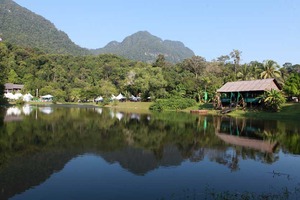
RWMF's natural concert backdrop, Mount Santubong.
Santubong, Sarawak, 15 July 2011. Once again the unique offering of Sarawak’s famous world music festival has left the audience hot and thirsty for more. Weather was partly to blame – it was scorching all three days (8-10 July). But the intimate show-and-tell - then jam like hell - afternoon workshops followed by nightly stellar acts is the success factor that draws thousands to the unassuming but charming Santubong Cultural Village.
The tradition of strumming authentic notes at the Rainforest World Music Festival (RWMF) began 14 years ago and still lives strong within the green canopy embraces of Mount Santubong. As you would expect in a rainforest, pure sounds that reverberate from nature find their soft landing in the hearts and souls of humans.
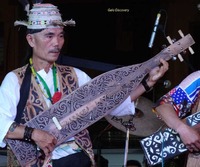
Heavenly tinkles from Matthew Ngau Jau
“Pathos in Purity” is how I would describe the categorically undemonstrative but alluring traditional acts. Masters of the Sape kicked off this series on the second stage, featuring sape maestros Mathew Ngau Jau with Asang and Tegit. A traditional Sarawakian stringed lute, the sape makes heavenly tinkles. Here’s a true story: when taken to Marseille in 1997 to perform for top music industry professionals there, the sape masters' humble performance reduced many to tears - quaint acoustics reflecting the beauty and innocence of Borneo’s surviving age-old tribe was just too unreal for those “hardened” music professionals.
AgungBeat from neighbouring Malaysian state of Sabah took over from the jungle sounds to a spirited communal gamelan comprising acoustics and vocals. The gamelan is a compendium of gongs, drums, xylophones and metallophones that are native to Malaysia and Indonesia. Roslee Wahid’s powerful vocals took traditional music lore and contemporary versions to stratospheric level. And it was just Day One.
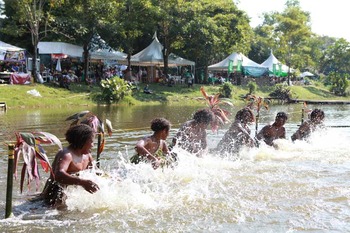
Water can make music too, as shown by Vanuatu islanders.
Leweton Women’s Water Music drove me to tears (though not a hardened musician, at least not yet), to hear for the first time, the voice of water. The simple Vanuatu women showed how it was possible to communicate with water; they stood in a line in the pond , water at waist-level and with bare hands swept, swooped, scooped and thumped the water surface to produce booms, dooshes and swishes. I’ve not heard anything quite like it! Dolphin squeak, whale whine, fish chatter, coral crackle – I hear these underwater, but the voice of water itself? These women from the remote islands of Vanuatu made time stand still as ancient traditions commanded over modern customs with the simplest and most fundamental of all elements – water.

Startijenn - bagpipe of traditions.
Pure and earnest sounds also came from Iskwew Aboriginal Women Singers from Canada. Wails, chants and spiritual incantation accompanied by rhythmic thumps of hand drums told stories of Mother Nature and her aches. Proud they sat in front of a perturbed audience as they held fast to the Cree tradition, playing foreign music, but bridging an important cultural gap. Sounding rather severe for a whole half hour, the crowd became restless. Their feet itched to dance.
Coming to the rescue was Brittany-based Startijenn that raised the fun bar by playing age-old instruments with spontaneous melody and danceable rhythm. According to tradition, the bombarde (wooden horn) is played typically with the biniou (Brittany’s bagpipe); the band also played the uileann pipes, accordeon diatonique (button accordion), drums and base.
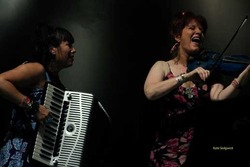
Lisa Haley (right): neo-traditional zydeco and cajun style and great vocals got everybody swinging
‘High-Wire Energy’ can also be used to describe Sarawak’s 14th year Rainforest World Music Festival as it featured one steroid-infused act after another. Who could walk away from ace performers Lisa Haley & the Zydecats? Bringing to life, no, bringing to electric level a once dying musical style – zydeco – Lisa Haley the violinist and vocalist, injects Cajun into a convivial medley. Great lyrics too, like “I got a paper in my shoe” from 1959 Boozoo Chavis and Eddie Shulman; “One side is a river, the other is a lake, Meet me in the middle and we'll eat King Cake” by Lisa Haley herself. Grammy nominated Lisa Haley is as amenable as she is talented, whose album I am definitely going to buy after I’ve written this piece.

Oud music redefined by Mehdi Haddab
DuOud made heavy metal fans beg for more of traditional oud (yes we are still talking about the Rainforest World Music Festival here). “We are known as bad boys,” yells Tunisian Jean Pierre performing next to master oud player Mehdi Haddab, then picked out a break beat synthesizer number to go with a “bad boy” refrain. Hair and sweat and heavy metal beats were in order, spreading out from the second (smaller) stage to the concert ground, setting the audience on fire. Mehdi thrilled the crowd by playing the oud above his head for a whole ten minutes or so – who needs LinkinPark?
The suited Blue Canyon Boys were great fun! It was consistently wow Colorado bluegrass rendition with vocals (a tad nasalized) and jangles (banjo) from the four mountain music lovers. So good they were that you could hear each instrument being played with technical mastery even from afar. And together it was a quartet of bluegrass quintessence!
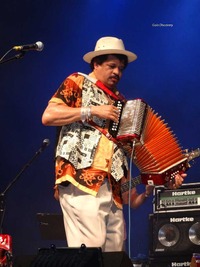
Infectious Latino Joaquin Diaz.
Another crowd pleaser with good Latino music was Joaquin Diaz. The Dominican Republic’s passion for to entertain was clear – there was no letting up with the accordion. His infectious style gets all jumping to their feet for a romp of salsa. So in love with music was Joaquin Diaz that he was seen jamming with other performers at the hotel lobby well after each concert night, and stopped when the kampong roosters crew (followed by a spectacular sunrise by the Damai seaside).
Frigg from Finland showed how it was just possible for young musicians to play instruments meticulously even in front of glaring spotlights and noisy crowds. All strings – violins, mandolin, guita, dobro – and foot stomping were enough to please the mind. Intelligent traditional music for the masses – yes it is possible. One score titled Oasis was melodiously haunting and heart wrenching. Unfortunately it is not in their latest Grannen album, which I am fortunate to possess, but in an earlier one I am told.
High energy South Italian boy band Kamafei pitched the festival to a higher octave with traditional pizzica-pizzica music with tambourine, but they failed to impress world music critics. The dance act was overly hip-hop, lead singer preferred to shout rather than sing, although a few numbers had infectious blends with reggae, rock and flamenco.
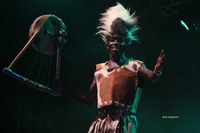
Kenge Kenge lives the Luo heritage
What world music festival is complete without the all-bewitching Africans? This year Kenge Kenge Orutu System cast a spell with handmade instruments, mime, deep vocals and gravity defying leg routines. “It is only when you make the instruments yourself that you can be satisfied with its sound,” says George Achieng, who has made too many orutu than he cares to remember. The Kenyans are certainly having fun while keeping the Luo musical heritage alive.
The anchor performance of the final night was the colourful and technically competent Kissmet from the UK. East did kiss West (or was it the other way around?) through these British Punjabis to produce imposing Bhangra rhythms underscored by rock, punctuated with ragas and bracketed in by funk. It was a sensational pleasure to watch and listen to, and to bop along to.
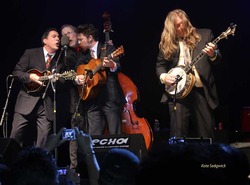
Blue Canyon - Colorado bluegrass quintessence
So this Borneo’s acclaimed annual world music event is not just by local acts (shocked when I was asked this recently) or estranged folk instruments (the more the merrier I say), it is about music with soul handed down by generations and made relevant through class acts for you and I. And if we buy their CDs or pay to download their MP3 albums, their music will live on for our future generations to appreciate as well.
On the whole, the 14th Rainforest World Music Festival with its afternoon workshops and nightly concerts was a great gig; not the best compared to the last couple of years, but still remarkable. If anything, it should pave the way for an even greater show ahead.
So see you next year, at the 15th Rainforest World Music Festival? It will take place 13-15 July 2012 at Santubong Cultural Village, Sarawak.
A few photos featured here are courtesy of Kate Sedgwick (read her blog!). Rest by Mallika Naguran and festival organiser sources.
Visit Sarawak Tourism Board and more Borneo tourism gigs http://www.sarawaktourism.com
and Rainforest World Music Festival highlights.